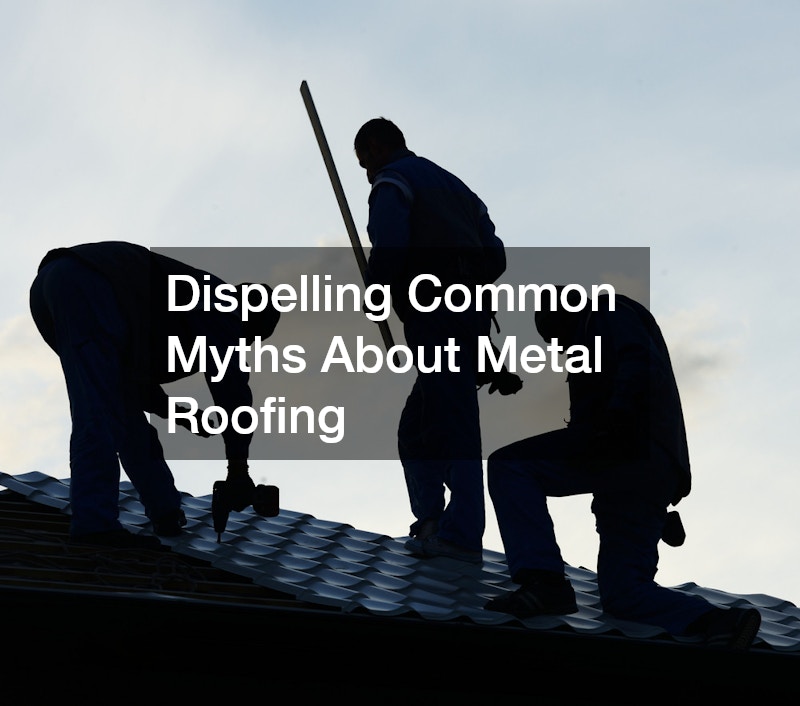Metal roofing has gained significant popularity in recent years, recognized for its durability, energy efficiency, and modern aesthetic. However, despite its growing acceptance, many myths and misconceptions still surround this roofing material, leading to misunderstandings about its advantages and suitability. In this article, we will dispel some of the most common myths about metal roofs, helping homeowners make informed decisions when considering this option for their homes.
One prevalent myth is that metal roofs are excessively noisy during rain or hail storms. This perception likely stems from older roofs that were installed without proper insulation or underlayment. In reality, modern metal roofing systems are designed with sound-dampening features that significantly reduce noise levels. With the right insulation and installation techniques, the sound of rain hitting a metal roof is often no louder than that of traditional asphalt shingles. Homeowners can enjoy the aesthetic and functional benefits of metal without the fear of disruptive noise.
Another common misconception is that metal roofs are prone to rust and corrosion. While it’s true that untreated metal can rust, most metal roof products are coated with protective finishes that enhance their longevity and resistance to the elements. For instance, galvanized steel, a popular choice for metal roofs, is treated with a protective zinc coating that prevents rust. Additionally, many roofing materials feature finishes that resist fading and chalking, ensuring they maintain their appearance and integrity for decades. Properly installed and maintained metal roofing can last 50 years or more without significant deterioration.
Some people believe that metal roofs are only suitable for certain architectural styles. While metal roofs are often associated with commercial buildings or barns, they are incredibly versatile and can complement a wide range of architectural designs. From traditional homes to modern structures, metal roofing is available in various styles, colors, and finishes that can enhance any property’s curb appeal. Homeowners can choose from standing seam panels, metal tiles, or corrugated sheets, ensuring that the roof aligns with their aesthetic preferences.
Another myth is that metal roofs attract lightning, which raises safety concerns for homeowners. In fact, metal roofing is no more likely to be struck by lightning than any other roofing material. In reality, metal is a non-combustible material that can help dissipate electrical energy, making it a safer option in lightning-prone areas. Additionally, metal roofs are often installed with proper grounding techniques, further enhancing their safety. Homeowners can rest assured that a metal roof will not increase the risk of lightning strikes.
A misconception persists that these roofs are significantly more expensive than other materials. While the initial cost of metal roofs may be higher than asphalt shingles, it’s essential to consider the long-term savings it offers. Metal roofing is highly durable and requires minimal maintenance, reducing the need for frequent repairs or replacements. Additionally, many metal roofs are energy-efficient, reflecting solar heat and potentially lowering cooling costs in the summer months. When factoring in the lifespan and energy savings, metal installations can be a cost-effective investment over time.
Some homeowners believe that metal roofs are not environmentally friendly. However, this assumption overlooks the benefits of metal as a sustainable roofing option. Most metal roofs are made from recycled materials and are themselves recyclable at the end of their life cycle. Furthermore, metal roofs can contribute to energy efficiency by reflecting heat away from the building, reducing the demand for air conditioning. Choosing a metal roof can significantly reduce a home’s environmental impact compared to traditional roofing materials.
Lastly, there is a myth that metal roofing requires specialized installation and is not suitable for DIY projects. While it is true that installing metal roofs can be more complex than some other materials, it is not beyond the capabilities of skilled DIY enthusiasts. With the right tools, training, and understanding of proper installation techniques, homeowners can successfully install roofing themselves. However, for those who prefer a guarantee of quality and longevity, hiring a professional contractor with experience in roofing installation is advisable.
Dispelling these common myths about this type of roofing can help homeowners better understand the benefits and practicality of this roofing material. With its durability, versatility, and energy efficiency, metal roofing is an excellent choice for many homes. By recognizing the truths behind these misconceptions, homeowners can make informed decisions that will enhance the beauty and performance of their properties for years to come. When considering roofing options, it’s essential to consult with professionals who can provide accurate information and guidance tailored to individual needs.
.


